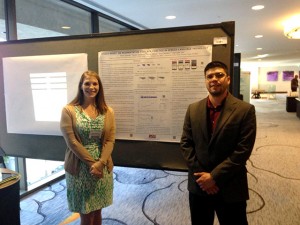
Telemedicine device developed to help treat communication disorders

ASU speech and hearing science doctoral student Rene Utianski (left) and electrical engineering student Steven Sandoval pose next to a poster illustrating the design and development of their award-winning telemedicine device.
Project lauded for technological innovation
Electrical engineering student Steven Sandoval and electrical engineering assistant professor Visar Berisha have played significant roles in a project to improve therapy for people in underserved communities who are living with communication disorders.
Sandoval teamed with two other Arizona State University students to develop Speaklear, a telemedicine device designed to enable speech-language pathologists to treat patients with communication disorders remotely.
The device won first place in a signal-processing technology application contest earlier this year organized by the Acoustical Society of America, and the project was recently a finalist in the sixth annual international Wireless Innovation Project competition sponsored by the Vodafone Americas Foundation, which is affiliated with one of the world’s largest telecommunications companies.
The project began as a collaborative effort by Berisha and Julie Liss.
Berisha has a joint appointment on the faculty of the School of Electrical, Computer and Energy Engineering, one of ASU’s Ira A. Fulton Schools of Engineering, and with the Department of Speech and Hearing Science in ASU’s College of Health Solutions.
Liss is an associate dean of the College of Health Solutions and a professor in the Department of Speech and Hearing Science.
They recruited the students to work on developing their idea for Speaklear and mentored the team. “The students did a masterful job,” Berisha said.
Interdisciplinary solution to worldwide problem
According to the World Health Organization, dysarthria, a motor speech disorder, affects approximately 46 million people worldwide, three million of whom live in the United States.
Dysarthria occurs when the muscles of the mouth, face and respiratory system fail to move or become weak after a stroke or brain injury. Symptoms may include slurred speech, hoarseness and a weak voice.
“It can be difficult for people to access treatment from trained speech-language pathologists, especially in communities outside of metropolitan areas, leaving their disorder untreated,” said project team member Rene Utianski, a speech and hearing science doctoral student.
Sandoval and Utianski were joined by Nicole Lehrer, a media arts and sciences doctoral student in the School of Arts, Media and Engineering in ASU’s Herberger Institute for Design and the Arts.
“Our team was awesome,” Utianski said. “Steven has a solid engineering background and was able to translate what I had in my head of what an speech-language pathologist would find helpful and apply it to the application. His technical skills and ingenuity blew me away.”
Utianski said Lehrer brought multifaceted talent to the endeavor: “In addition to her degrees in biomedical engineering and painting, she is part of a team of students developing a home-based stroke rehabilitation system. Her background complemented our efforts beautifully.”
Health solution for underserved communities
Speaklear works like any other application on smartphones or tablets. After it records speech samples, it provides a variety of calculations to assess speech production. This process helps the pathologist pinpoint the areas that are most problematic.
A traditional in-office therapy session draws upon the pathologists’ training as much as it does their perceptual experience to hone in on problem areas, allowing them to cater the therapy to meet the needs of the patient.
The Speaklear project team worked with 25 pathologists and audiologists in the Phoenix area with at least 20 years of experience in the field to develop the traditional portion of the calculation.
Utianski said the team was pleased to discover that not only were the experts willing to participate in the development of Speaklear, but also most were anxious to start using it.
“They see this as a partial solution to the longstanding shortage of speech-language pathologists, particularly in rural areas,” she said.
“The best part, for me, was working with a diverse, passionate team that brought so much talent to the table,” Utianski said. “It’s amazing what a small group of dedicated people can do in making a big impact on the lives of others.”
Media Contacts
Joe Kullman, [email protected]
(480) 965-8122
Ira A. Fulton Schools of Engineering
Melissa Wenzel, [email protected]
(602) 496-0915
College of Health Solutions
College of Nursing & Health Innovation



































